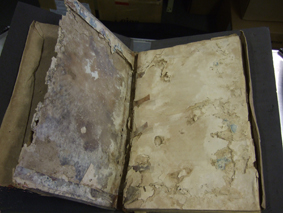On your visit to The National Archives, you get your reader’s ticket to order up the documents you are interested in seeing but, after entering the document references into Discovery, a document comes up as ‘unfit for production’. So, you wonder, what does that mean?

Unfit document - Detail of damage to an unfit document
Items designated ‘unfit for production’ are in such vulnerable physical condition that producing them would present a risk to the document – unfit documents could be extremely fragile, they could be blocked (all the pages stuck together in a volume or a roll), or perhaps they could be damaged by mould. These are the documents that, when you open the box, you immediately jump to put the top back on and quickly hide it at the bottom of the pile, hoping that it will miraculously disappear!
Well, here in the Collection Care Department we are rising to the daunting challenges these documents present to the conservation professional!
Behind the scenes we manage the ‘Unfit Database’ – a record of all 8,232 items in the collection previously identified as at risk and that had been removed from public access for this reason. Over the past couple of years we have been committed to reducing the number of documents classed as ‘unfit’ by applying a more consistent approach to categorising documents and enabling new ways to support readers with these fragile items. Many formerly unfit items can now be seen under supervision in our invigilation room or in the Collection Care Department where staff will be available to assist you in handling these fragile documents. In fact, over 75% of those documents that were previously inaccessible can now be seen immediately! But we’re not going to stop there…
Items currently identified as unfit for production are actually of two very different types: those that require mould cleaning and those that require extensive conservation treatment.
Those documents identified as mould damaged need to be cleaned. Mould needs to be removed, as active spores can quickly spread to unaffected documents. Mould cleaning is something we do routinely on request and can be arranged in advance of your visit provided we are given a certain amount of notice. In fact, approximately 65% of those documents that cannot be produced immediately fall into this category.
Unfit items that need conservation treatment before they can be produced are considerably more labour and time intensive. They will require an individual specialist conservation assessment, research into possible treatment options and time to test and carry out the conservation treatment. However, if an unfit item is vital for research please contact staff at Kew with your query. The Collection Care Department is also investigating future projects that will hopefully enable us to further systematically reduce the number of unfit documents.
Ultimately we’d like to see the number of unfit documents reduced to zero. Maybe that’s possible and maybe it isn’t, but we still want to get as many of them into your hands as we can!